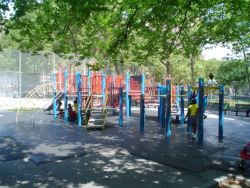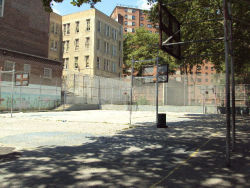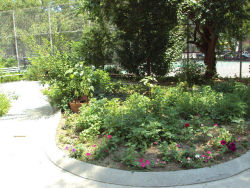Playground One Twenty Five CXXV
Playground 125
This playground is named for 125th Street, which bounds the property to the north, and for the adjacent P.S. 125, also known as the Ralph Bunche School. A major approach to the Triborough Bridge, 125th Street is the only cross-town commercial passage above midtown Manhattan and below Washington Heights. It lies along what was once known as the Harlem Valley; before development, the Valley was a narrow strip of land that ran below Harlem Heights, connecting Harlem Plain, to the east, with the Hudson River. This path has played an integral role in Harlem’s development since 1658, when Peter Stuyvesant (1610-1672) founded the village of Nieuw Haarlem on what is now 125th Street and First Avenue.
Harlem was once a small, isolated village, joined to the rest of New York City only by horse car lines and a steamboat that plied a route between 125th Street and Peck Slip. The construction of the New York and Harlem Railroad station at 125th Street and Fourth Avenue (now Park Avenue) in 1837 marked the beginning of Harlem’s growth, but it was the introduction of four elevated train lines in the 1880s that set off a population explosion. An enormous number of people from a variety of ethnic backgrounds poured into the area, and 125th Street was the commercial center of it all. A real estate boom, economic growth, and the construction of notable buildings such as the Mount Morris Bank Building, the YMCA, and Oscar Hammerstein’s Harlem Opera House, all inside of 25 years, established Harlem as a distinct part of New York City. With the influx of African Americans from the South and immigrants from the Caribbean in the early twentieth century, 125th Street became a center of black intellectual, political, and cultural activity.
Nearby P.S. 125 is named in honor of Ralph Bunche (1904-1971), an American educator, political scientist, and United Nations mediator. A small park across from the United Nations also honors his contributions to world peace. Bunche was born in Detroit, Michigan, the son of a barber and the grandson of a former slave. After receiving his undergraduate education at the University of California at Los Angeles and earning graduate degrees from Harvard, Bunche taught at Howard University, where he established and chaired the political science department. He later returned to Harvard to teach. He wrote two books, A World View of Race (1936) and An American Dilemma (1944), a study of blacks in America conducted in collaboration with the Swedish sociologist Gunnar Myrdal.
Bunche worked for the Office of Strategic Services (which became the Central Intelligence Agency) during World War II (1939-1941), and later for the State Department, before joining the United Nations Secretariat in 1947, working as a mediator for peace throughout Africa and the Middle East. From January through July 1949, Bunche successfully brokered the four armistice agreements between Israel and the Arab states that ended the 1948-49 Arab-Israeli War. For his efforts he was awarded the Nobel Peace Prize in 1950; he was the first African-American to receive this award. In 1955, Bunche was appointed Undersecretary of the United Nations (the post was changed to Undersecretary General in 1969) and, in 1957, Secretary for Special Political Affairs. He also directed peacekeeping operations for the United Nations and was responsible for their program on peaceful uses of atomic energy. For a lifetime of extraordinary achievement in the international arena, President John F. Kennedy (1917-1963) awarded him the United States Medal of Freedom in 1963. Bunche retired from the United Nations in 1971 and died in New York City that same year.
The City acquired playground 125, located on Manhattan Avenue between 123rd and 125th Streets, in 1948. It is jointly operated by Parks and the Board of Education, in the schoolyard of the Ralph Bunche School. Renovations to the playground were completed in May 2000, with help from the Junior League of the City of New York, volunteers from the Ralph Bunche School, and the City Parks Foundation. A total of 15,000 hours of volunteer labor, project planning, and administrative support went into the project, which cost $41,000 and was funded by Mayor Giuliani. Volunteers painted a new mural, designs for hopscotch, four square, and race tracks, and planted flowers and bushes in the adjacent community garden. The renovation also included the installation of new play equipment. The ribbon cutting, on May 30, 2000, featured poetry and performances by students of the Ralph Bunche School.
Check out your park's Vital Signs
Clean & Safe
Green & Resilient
Empowered & Engaged Users
Share your feedback or learn more about how this park is part of a
Vital Park System



